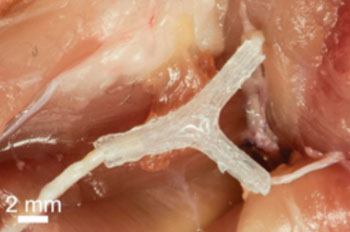3-D Scanning and Printing Technology Enable Complex Nerve Regeneration in Rat Model
By LabMedica International staff writers
Posted on 06 Oct 2015
A novel three-dimensional printing approach has enabled the regeneration of a complex nerve in a rat model system.Posted on 06 Oct 2015
Investigators at the University of Minnesota (Minneapolis, USA) and their colleagues at several other research institutes used sophisticated imaging technology to produce a three-dimensional map of the structure of a rat's sciatic nerve. A custom-built three-dimensional printer was then used to fabricate a silicone guide for regrowth of the nerve. The guide incorporated both physical and biochemical cues to promote regeneration of the nerve.

Image: A three-dimensional printed nerve regeneration pathway implanted in a rat (Photo courtesy of the University of Minnesota College of Science and Engineering).
In vitro studies showed that three-dimensional printed physical and biochemical cues in the guide provided axonal guidance and chemotractant/chemokinetic functionality.
The guide was implanted into a rat by surgically grafting it to the cut ends of the sciatic nerve. Results published in the September 18, 2015, online edition of the journal Advanced Functional Materials revealed that in vivo studies examining the regeneration of bifurcated injuries across a 10 millimeter complex nerve gap in rats showed that the three-dimensional printed scaffolds achieved successful regeneration of complex nerve injuries, resulting in enhanced functional return of the regenerated nerve.
"This represents an important proof of concept of the three-dimensional printing of custom nerve guides for the regeneration of complex nerve injuries," said senior author Dr. Michael McAlpine, professor of mechanical engineering at the University of Minnesota. "Someday we hope that we could have a three-dimensional scanner and printer right at the hospital to create custom nerve guides right on site to restore nerve function. The exciting next step would be to implant these guides in humans rather than rats. In cases where a nerve is unavailable for scanning, there could someday be a "library" of scanned nerves from other people or cadavers that hospitals could use to create closely matched three-dimensional-printed guides for patients."
Related Links:
University of Minnesota













